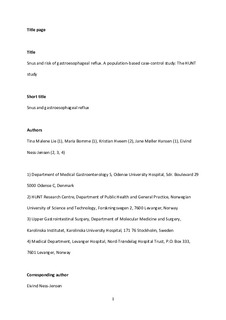Snus and risk of gastroesophageal reflux. A population-based case-control study: the HUNT study
Journal article, Peer reviewed
Accepted version
Permanent lenke
http://hdl.handle.net/11250/2488925Utgivelsesdato
2017Metadata
Vis full innførselSamlinger
Originalversjon
Scandinavian Journal of Gastroenterology. 2017, 52 (2), 193-198. 10.1080/00365521.2016.1245775Sammendrag
Objective: Tobacco smoking is a risk factor for gastroesophageal reflux, but whether other tobacco products increase the risk is unclear. The aim of this study was to investigate if snus increases the risk of gastroesophageal reflux symptoms (GERS).
Material and methods: The study was based on the third Nord-Trøndelag health study (HUNT3), a population-based study of all adult residents in Nord-Trøndelag County, Norway, performed in 2006–2009. The association between self-reported severe heartburn/regurgitation and snus use was assessed by logistic regression.
Results: Compared to never snus users, daily snus users had a reduced risk of GERS (OR 0.77, 95% confidence interval [CI] 0.64–0.93), while previous snus users and those using <2 boxes of snus/month had an increased risk (OR 1.20, 95% CI 1.00–1.46 and OR 1.41, 95% CI 1.02–1.96, respectively). There was no association between age when starting using snus and GERS. Snus users who started using snus to quit or cut down on cigarette smoking, who started using both snus and cigarettes or cigarettes alone had an increased risk of GERS. Snus users <30 years of age had an increased risk of GERS (OR 1.49, 95% CI 1.02–2.16), while those aged between 50–60 and 60–70 years had a reduced risk (OR 0.67, 95% CI 0.49–0.93 and OR 0.51, 95% CI 0.28–0.94, respectively).
Conclusions: Daily snus users had a reduced risk of GERS. However, previous snus users and subgroups of snus users had an increased risk of GERS indicating reverse causality, such that snus use could increase the risk of GERS.
